Abstract
Three-dimensional (3D) models of orebodies and deposits can provide strong support for quantitative evaluation of mineral resources. However, 3D modeling of ore deposits based on limited mineral exploration data remains a challenge due to the non-stationarity of the spatial distribution of orebodies and the uncertainty of data and models. Stochastic methods based on multiple-point geostatistics (MPS) have shown promise in automatic 3D characterization of complex geological structures (e.g., minerals, rocks, facies). However, as an essential element of MPS methods, a credible training image is difficult to obtain in real 3D applications. The spatial distribution of orebodies is critically non-stationary because the formation and evolution of a deposit are complex and its shape and distribution are controlled by faults, surrounding rock and other structures. In this work, we propose a feature-enhanced MPS-based approach, namely FE-3DRCS, by combining the characteristics of geological exploration data distribution following a MPS method called 3DRCS. To reduce the influence of non-stationarity of orebodies, a spatial stationarity enhancement strategy is presented. Besides, the artifact elimination strategy of spatial features and the adaptive optimization strategy based on an iterative mechanism are integrated in our approach. By performing FE-3DRCS on the geological exploration data in the Luodang Cu deposit, southwestern China, a set of 3D deposit models and Cu grade models were built. A series of morphological comparisons and statistical analyses were followed to evaluate the spatial distribution characteristics of orebodies. The Cu reserve was also evaluated based on the built 3D grade models. The real application confirms that FE-3DRCS can be applied effectively in the fields of 3D characterization and quantitative evaluation of mineral resources.



















Similar content being viewed by others
References
Aitokhuehi, I., & Durlofsky, L. J. (2005). Optimizing the performance of smart wells in complex reservoirs using continuously updated geological models. Journal of Petroleum Science and Engineering, 48(3–4), 254–264.
Arpat, G. B., & Caers, J. (2007). Conditional simulation with patterns. Mathematical Geology, 39(2), 177–203.
Boisvert, J. B., Pyrcz, M. J., & Deutsch, C. V. (2007). Multiple-point statistics for training image selection. Natural Resources Research, 16(4), 313–321.
Caers, J. (2001). Geostatistical reservoir modeling using statistical pattern recognition. Journal of Petroleum Science and Engineering, 29, 177–188.
Caumon, G., Collon-Drouaillet, P., De Veslud, C. L. C., Viseur, S., & Sausse, J. (2009). Surface-based 3D modeling of geological structures. Mathematical Geosciences, 41(8), 927–945.
Chen, Q., Liu, G., Li, X., Zhang, Z., & Li, Y. (2017). A corner-point-gridbased voxelization method for the complex geological structure model with folds. Journal of Visualization, 20(4), 875–888.
Chen, Q., Liu, G., Ma, X., Li, X., & He, Z. (2020). 3D stochastic modeling framework for quaternary sediments using multiple-point statistics: A case study in Minjiang Estuary area, southeast China. Computers & Geosciences, 136, 104404.
Chen, Q., Liu, G., Ma, X., Zhang, J., & Zhang, X. (2019). Conditional multiple-point geostatistical simulation for unevenly distributed sample data. Stochastic Environmental Research and Risk Assessment, 33(4), 973–987.
Chen, Q., Mariethoz, G., Liu, G., Comunian, A., & Ma, X. (2018). Locality-based 3-D multiple-point statistics reconstruction using 2-D geological cross sections. Hydrology and Earth System Sciences, 22(12), 6547–6566.
Comunian, A., Renard, P., & Straubhaar, J. (2012). 3D multiple-point statistics simulation using 2D training images. Computers & Geosciences, 40, 49–65.
Cui, Z., Chen, Q., Liu, G., Ma, X., & Que, X. (2021a). Multiple-point geostatistical simulation based on conditional conduction probability. Stochastic Environmental Research and Risk Assessment, 35(7), 1355–1368.
Cui, Z., Chen, Q., Liu, G., Mariethoz, G., & Ma, X. (2021b). Hybrid parallel framework for multiple-point geostatistics on Tianhe-2: A robust solution for large-scale simulation. Computers & Geosciences, 157, 104923.
de Vries, L. M., Carrera, J., Falivene, O., Gratacós, O., & Slooten, L. J. (2009). Application of multiple point geostatistics to non-stationary images. Mathematical Geosciences, 41(1), 29–42.
Deutsch, C. V. (1998). Cleaning categorical variable (lithofacies) realizations with maximum a-posteriori selection. Computers & Geosciences, 24(6), 551–562.
Deutsch, C. V., & Tran, T. T. (2002). FLUVSIM: A program for object-based stochastic modeling of fluvial depositional systems. Computers & Geosciences, 28(4), 525–535.
Feng, W., Yin, Y., Zhang, C., Duan, T., Zhang, W., Hou, G., & Zhao, L. (2019). A training image optimal selecting method based on composite correlation coefficient ranking for multiple-point geostatistics. Journal of Petroleum Science and Engineering, 179, 292–311.
Genest, C., & Zidek, J. V. (1986). Combining probability distributions: A critique and an annotated bibliography. Statistical Science, 1(1), 114–135.
Guardiano, F. B., & Srivastava, R. M. (1993). Multivariate geostatistics: Beyond bivariate moments. In A. Soares (Ed.), Geostatistics troia’92 (pp. 133–144). Springer.
Gueting, N., Caers, J., Comunian, A., Vanderborght, J., & Englert, A. (2018). Reconstruction of three-dimensional aquifer heterogeneity from two-dimensional geophysical data. Mathematical Geosciences, 50(1), 53–75.
Guo, J., Wang, X., Wang, J., Dai, X., Wu, L., Li, C., Li, F., Liu, S., & Jessell, M. W. (2021). Three-dimensional geological modeling and spatial analysis from geotechnical borehole data using an implicit surface and marching tetrahedra algorithm. Engineering Geology, 284, 106047.
Heinz, J., Kleineidam, S., Teutsch, G., & Aigner, T. (2003). Heterogeneity patterns of Quaternary glaciofluvial gravel bodies (SW Germany): Application to hydrogeology. Sedimentary Geology, 158(1–2), 1–23.
Hoffman, B. T., & Caers, J. (2007). History matching by jointly perturbing local facies proportions and their spatial distribution: Application to a North Sea reservoir. Journal of Petroleum Science and Engineering, 57(3–4), 257–272.
Hong, J., & Oh, S. (2021). Model selection for mineral resource assessment considering geological and grade uncertainties: Application of multiple-point geostatistics and a cluster analysis to an iron deposit. Natural Resources Research, 30(3), 2047–2065.
Hou, W., Liu, H., Zheng, T., Shen, W., & **ao, F. (2021). Hierarchical MPS-based three-dimensional geological structure reconstruction with two-dimensional image (s). Journal of Earth Science, 32(2), 455–467.
Huang, J., Mao, X., Chen, J., Deng, H., Dick, J. M., & Liu, Z. (2020). Exploring spatially non-stationary relationships in the determinants of mineralization in 3D geological space. Natural Resources Research, 29(1), 439–458.
Jackson, M. D., Percival, J. R., Mostaghimi, P., Tollit, B. S., Pavlidis, D., Pain, C. C., Gomes, J. L. M. A., EI-Sheikh, A. H., Salinas, P., Muggeridge, A. H., & Blunt, M. J. (2015). Reservoir modeling for flow simulation by use of surfaces, adaptive unstructured meshes, and an overlap**-control-volume finite-element method. SPE Reservoir Evaluation & Engineering, 18(02), 115–132.
Kessler, T. C., Comunian, A., Oriani, F., Renard, P., Nilsson, B., Klint, K. E., & Bjerg, P. L. (2013). Modeling fine-scale geological heterogeneity—Examples of sand lenses in tills. Groundwater, 51(5), 692–705.
Laurent, G., Ailleres, L., Grose, L., Caumon, G., Jessell, M., & Armit, R. (2016). Implicit modeling of folds and overprinting deformation. Earth and Planetary Science Letters, 456, 26–38.
Li, X., Yuan, F., Zhang, M., Jowitt, S. M., Ord, A., Zhou, T., & Dai, W. (2019). 3D computational simulation-based mineral prospectivity modeling for exploration for concealed Fe–Cu skarn-type mineralization within the Yueshan orefield, Anqing district, Anhui Province, China. Ore Geology Reviews, 105, 1–17.
Mariethoz, G., & Renard, P. (2010). Reconstruction of incomplete data sets or images using direct sampling. Mathematical Geosciences, 42(3), 245–268.
Mariethoz, G., Renard, P., & Straubhaar, J. (2010). The direct sampling method to perform multiple-point geostatistical simulations. Water Resources Research, 46, w11536.
Pyrcz, M. J., Boisvert, J. B., & Deutsch, C. V. (2009). ALLUVSIM: A program for event-based stochastic modeling of fluvial depositional systems. Computers & Geosciences, 35(8), 1671–1685.
Pyrcz, M. J., & Deutsch, C. V. (2014). Geostatistical reservoir modeling. Oxford University Press.
Raiber, M., White, P. A., Daughney, C. J., Tschritter, C., Davidson, P., & Bainbridge, S. E. (2012). Three-dimensional geological modelling and multivariate statistical analysis of water chemistry data to analyse and visualise aquifer structure and groundwater composition in the Wairau Plain, Marlborough District, New Zealand. Journal of Hydrology, 436, 13–34.
Ritzi, R. W., Jr. (2000). Behavior of indicator variograms and transition probabilities in relation to the variance in lengths of hydrofacies. Water Resources Research, 36(11), 3375–3381.
Shao, Y., Zheng, A., He, Y., & **ao, K. (2011). 3D geological modeling and its application under complex geological conditions. Procedia Engineering, 12, 41–46.
Stone, M. (1961). The opinion pool. The Annals of Mathematical Statistics, 32, 1339–1342.
Straubhaar, J., Renard, P., & Chugunova, T. (2020). Multiple-point statistics using multi-resolution images. Stochastic Environmental Research and Risk Assessment, 34(2), 251–273.
Strebelle, S. (2002). Conditional simulation of complex geological structures using multiple-point statistics. Mathematical Geology, 34(1), 1–21.
Tran, T. T. (1994). Improving variogram reproduction on dense simulation grids. Computers & Geosciences, 20(7–8), 1161–1168.
Vassena, C., Cattaneo, L., & Giudici, M. (2010). Assessment of the role of facies heterogeneity at the fine scale by numerical transport experiments and connectivity indicators. Hydrogeology Journal, 18(3), 651–668.
Wang, L., Yin, Y., Zhang, C., Feng, W., Li, G., Chen, Q., & Chen, M. (2022). A MPS-based novel method of reconstructing 3D reservoir models from 2D images using seismic constraints. Journal of Petroleum Science and Engineering, 209, 109974.
Yang, L., Hou, W., Cui, C., & Cui, J. (2016). GOSIM: A multi-scale iterative multiple-point statistics algorithm with global optimization. Computers & Geosciences, 89, 57–70.
Yarus, J. M., & Chambers, R. L. (1994). Stochastic modeling and geostatistics (p. 231). AAPG.
Zeng, M., Zhang, D., Zhang, Z., Li, T., Li, C., & Wei, C. (2018). Structural controls on the Lala iron–copper deposit of the Kangdian metallogenic province, southwestern China: Tectonic and metallogenic implications. Ore Geology Reviews, 97, 35–54.
Zhu, Z., Tan, H., Liu, Y., & Li, C. (2018). Multiple episodes of mineralization revealed by Re–Os molybdenite geochronology in the Lala Fe–Cu deposit, SW China. Mineralium Deposita, 53(3), 311–322.
Acknowledgments
We are grateful to the editors, and the anonymous referee for their insightful comments and suggestions toward improving the research enclosed in this paper. This work is supported by the National Natural Science Foundation of China (42172333, 41902304, U1711267). The datasets analyzed during the current study are available from the corresponding author on reasonable request (chenqiyu403@163.com).
Author information
Authors and Affiliations
Corresponding author
Ethics declarations
Conflict of Interest
The authors declare that they have no known competing financial interests or personal relationships.
Rights and permissions
Springer Nature or its licensor holds exclusive rights to this article under a publishing agreement with the author(s) or other rightsholder(s); author self-archiving of the accepted manuscript version of this article is solely governed by the terms of such publishing agreement and applicable law.
About this article
Cite this article
Liu, G., Fang, H., Chen, Q. et al. A Feature-Enhanced MPS Approach to Reconstruct 3D Deposit Models Using 2D Geological Cross Sections: A Case Study in the Luodang Cu Deposit, Southwestern China. Nat Resour Res 31, 3101–3120 (2022). https://doi.org/10.1007/s11053-022-10113-z
Received:
Accepted:
Published:
Issue Date:
DOI: https://doi.org/10.1007/s11053-022-10113-z




